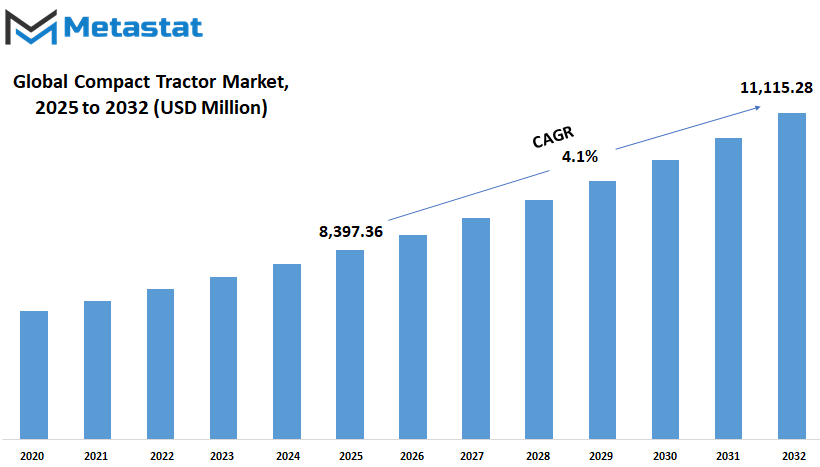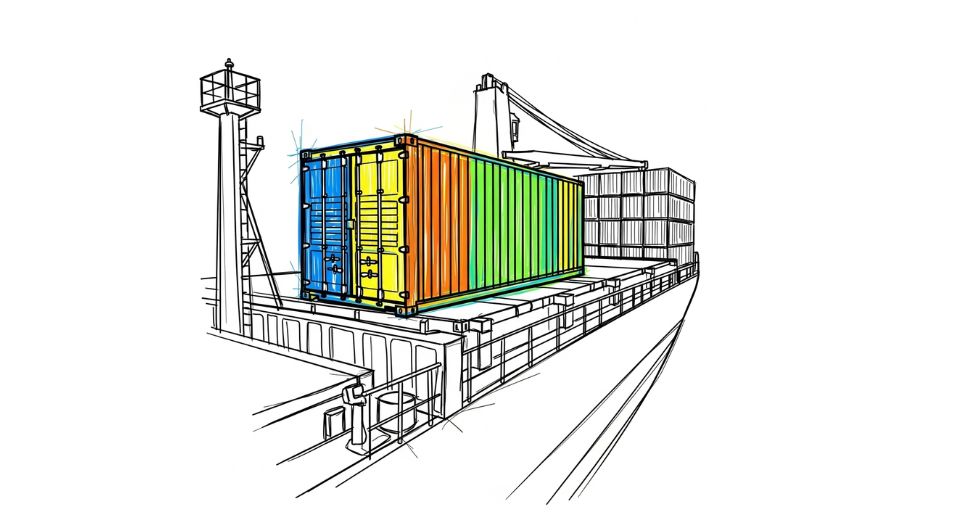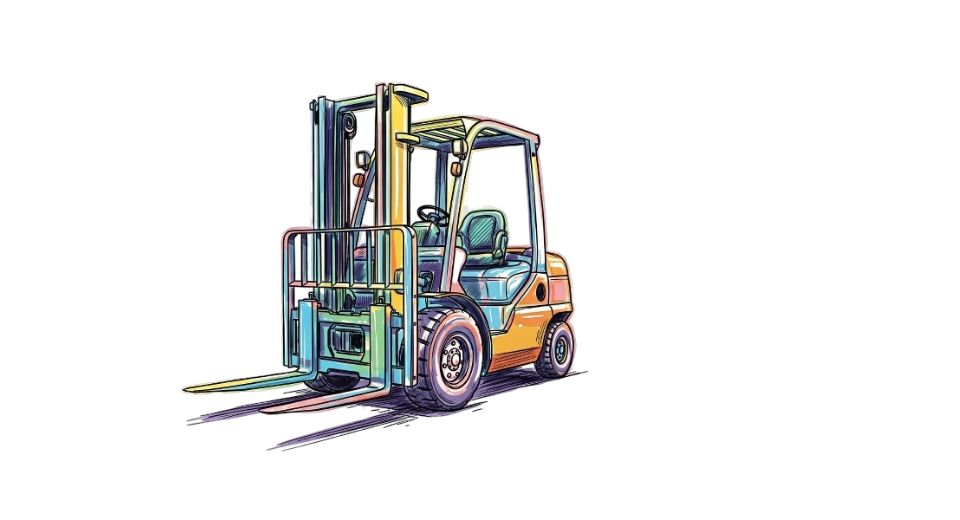MARKET OVERVIEW
The Global Compact Tractor market is increasingly going to be the defining operational landscape of small to medium farming, landscaping, and estate management. Compacts are unlike all other large-scale agricultural equipment. In fact, there is no definition of what compacts do. Most small landowners and all type of businesses cannot afford equipment that will be used to do multiple chores on limited wide areas. The market will go ahead with constant development as manufacturers will offer equipment useful for specialized needs in soil preparation, hauling, mowing, and light construction tasks.
Designed primarily for general farm operations, compact tractors are lighter and more versatile than their full-sized counterparts. Further acceptance and the eventual establishment of the Global Compact Tractor market will be through varied designs, ergonomic and easy-to-use controls, as well as an extensive range of attachments. Such machines are prepared for different activities, points of location during a season, and across land types, making possible activities such as tilling during spring and snow removal in winter. Continuing to attract much attention in regions where land use varies and labor efficiency is a priority.
The Global Compact Tractor market would broaden its scope towards the introduction of models that would be equipped with digital control systems and mechanical advancements that would decrease operator fatigue. Technological upgrades in hydraulics, power steering, and transmission systems would become taken for granted by the customers who would seek reliable performances on uneven or constrained plots. As demands definitely would shift to productivity growth and better conditions regarding the environment, alternative fuel capabilities and emission control technologies according to regional regulations would also be found in compact tractors.
This is not coming to an end of compact tractors only for agricultural settings. Much of the municipal and much of the landscaping operations, also by vineyard managers and greenhouse operators, will certainly turn toward compact tractors for their day-to-day usage. With smaller footprints coupled with greater ease of storage, they are best suited for urban and peri-urban environments, especially within areas where space restrictions render impractical the use of larger machines. In ruggedness and refinement-aspects, the Global Compact Tractor market will be meeting this phenomenally important trend in presenting machinery that would address the workload diversity presented by non-farming users while retaining a certain degree of robust functionality and operational simplicity.
The specific nature of the product offerings will be shaped regionally. Compact tractors will be indispensable tools for both productivity and transportation in areas with fragmented holdings or developing rural infrastructure projects. The market will adapt to climatic conditions and local land management practices by conceiving new variants with customized engine capacities, ground clearance, and safety features. Such changes will allow efficient operations, irrespective of working environments.
In addition to constructing service networks and financing options lowering entry barriers for many small business owners and independent operators, conveying the message is that manufacturers participating in the Global Compact Tractor market will start developing customer-centric solutions. As builders will place compact tractors as mechanized implement today but will also keep them Multilaterally, they will put them into the ranks where using mechanized labor will be high across different sectors in the coming times.
This is how the Global Compact Tractor market will establish itself-as an ongoing basis for future development and designing the engines in which most basic and unquestionable needs will be transformed into significant and increasingly agile market segments under constant change in design and utility.
Global Compact Tractor market is estimated to reach $11,115.28 Million by 2032; growing at a CAGR of 4.1% from 2025 to 2032.

GROWTH FACTORS
The global compact tractor market is projected to grow steadily over the coming years on account of the changing scenario in farming and the increasing demand for more productive equipment. The shift in agriculture from the orthodox methods to the more modern is increasing the demand for machines that go well with compactness and productivity. There are compact tractors that have become increasingly significant to small and medium-scale farmers, where flexibility and ease of operation are necessary. These machines provide a logical solution for those farmers who are trying to enhance productivity without incurring the need for oversized equipment that may not be well-suited to their land or budget.
With the rising demand for versatile farming tools, it has become one of the reasons pushing the trend in an upward direction. In many areas, particularly where farms are smaller or land is more fragmented, compact tractors fit better than larger alternatives. They are easy to handle and more fuel-efficient and can perform a variety of tasks, such as tilling, mowing, and loading. Hence, these tractors are a worthy buy for those trying to maximize limited resources. Meanwhile, a clear trend in mechanized farming is developing within the areas of growing markets. Starting to modernize agriculture in these regions has made the need for reliable small-to-medium-scale machines ever more pressing. Compact tractors can satisfy this need by furnishing just enough power to accomplish the essential functions without requiring the large injection of capital that larger machines would.
The challenges start with the upfront cost of purchasing a compact tractor, one such factor. Small farms or new entrants into the farming business could find it difficult to handle such costs. These hindrances may lead to not adopting them, especially in some parts of the world where credit access is limited. Plus, while compact tractors are a useful alternative, there are also limitations. When it comes to demanding operations on larger farms, they simply cannot deliver the same power and capacity as the bigger tractors. These limitations may slightly hinder their progress in the market.
However, looking ahead is bright. A new opportunity is expected to arise as more nations continue to invest in agricultural development. Emerging markets, in particular, may see a rising interest in compact tractors as they expand their farming activities. Improved financing and innovation to improve compact tractor performance incorporates further opportunities. All these developments may trigger the Global Compact Tractor market, which in turn will inspire continued interest and a steady step forward for the industry.
MARKET SEGMENTATION
By Capacity
The global compact tractor market is adopting more of an outline through the changing agriculture needs, technology improvement, and focus on efficiency. Farmers and landowners are beginning to seek equipment beyond traditional equipment and, instead, are looking for machinery that will be user-friendly, cost-effective, and smaller jobs achievable without performance loss. Compact tractors have developed into a practical option for managing most smaller plots for landscaping, horticulture, and light construction work. Their ever-growing popularity is due to the combination of power and size, thus making them more multifunctional compared to larger, bulkier tractors.
Going forward, the market is likely to experience steady growth in different below 20 HP categories. Compact tractors under 20 HP will, therefore, have a market value of USD 2,182.26 million in fit for 2025. These machines are most commonly used for garden maintenance and light-duty farm tasks, and their affordability and simplicity attract entry and small-scale farmers. Following are likely to be valued at USD 2,976.43 million: models within the 21 HP to 30 HP range; this capacity range is increasingly becoming the darling of users who need just a little extra for medium-level farming or commercial grounds-keeping.
Tractors of about 31 HP to 40 HP are estimated to yield about USD 1,807.09 million. These tractors can handle most mowing and similar tasks, but they have a compact frame that lends itself to mobility in tighter places. As the farming methods change, this sector may have even higher demand from professionals that require a good-performing machine for different kinds of work in the near future. Meanwhile, units in the 41 HP-to-50 HP category are projected to grow further at USD 942.45 million. They are commonly chosen by users looking for equipment that can perform well without having to go to the size and cost those larger agricultural machines have. Finally, the segment of 51 to 60 HP is projected at USD 489.13 million by 2025, mostly serving specific needs, especially in commercial agriculture or for maintaining large properties.
Into the future, compact tractors are evolving: manufacturers are already working on hacks to improve automation, fuel efficiency, and comfort. As technologies become increasingly within reach, they will further spur users in taking to compact tractors, which not only simplify tasks but also manage resources better. It is likely that this market will continue to rise in response to more and more people seeing the value in machines whose simple usability, strength, and clever design are a part of.
By Transmission
The Global Compact Tractor market is expected to be on a steady growth path, with technology and customer demands being the main factors reshaping the way forward. An aspect most obviously observed in the transformation is segmentation of the market into transmission types, with Hydrostatic and Mechanical being two of the main ones. These two systems account for different user preferences and their future development is expected to influence the laws governing compact tractors.
Hydrostatic transmissions have been known to be quite easy. Instead of having to manually shift gears, the operator can control speed smoothly with the use of pedals. This makes the experience much less tiring for those wanting to use the machine for long periods of time. It is particularly useful in small-scale farming, landscaping and any other task requiring very frequent direction changes or needing very fine speed control. Because of this, there are good chances of having more customers leaning toward hydrostatic systems, especially when more people from non-agricultural backgrounds move into small-scale farming or hobby farming. With comfort and user-friendliness having been paramount, hydrostatic compact tractors are expected to be in demand.
Mechanical transmissions are steadily keeping a ground with regard to their robustness and control they offer. Farmers or professionals who know machines would take that option if they mostly worked under rough or demanding conditions. Simpler and easy for repairs at the remote ends, those systems are good bets for the buyers preferring long-term dependability. Indeed, even with the development of modern models, mechanical systems are projected to be on the market due to their inexpensive costs and practical advantages.
Looking into the future, both transmission types are much likely to reach high technical refinement and even better performance. Design and efficiency improvements may put an even finer edge on both options. Manufacturers are on their way to find the marriage of user-friendliness and strength, which would mean compact tractors that perform well without losing comfort. Feedback from the customers shapes a lot of these advancements as adapting to equipment that doesn't have to be purely commercial will become a necessity for more users.
However, as the Global Compact Tractor Market evolves and innovates, so much will change with the machines from here on out into the future in the way they are designed and operated. Choosing between hydrostatic and mechanical transmissions is clear-cut today; however, the industry will continue evolving with respect to future changes and shifting preferences.
By Drive Type
Future of Global Compact Tractor Industry: Among the defining elements of the future for the market are shifts in the demands of farming; increasingly tasked land managing institutions and expanding infrastructure support in both urban and rural areas. Gradually, compact tractors come to be considered part of small to medium operations. Compacts are on offer as more people see and find it worthwhile to own efficient machinery that is capable of handling many tasks, without the bulk and cost typical of larger machinery. All this has raised the manufacturers' bar to come up with innovations that improved performance while keeping tractors user-friendly.
Expectedly, the drive type would strongly influence how the Global Compact Tractor market would evolve in future. Two major segments make up their division according to drive type - Two-Wheel Drive and Four-Wheel Drive. Traditionally, two-wheel drive compact tractors have been found more commonly among places that have flat geographic features in addition to an area where heavy lifting is rarely applied. Because these tractors come down at a lesser fee, they provide a great deal of allure to small landowners and garden centers availing of light duties.
On the contrary, however, four-wheel-drive compact tractors are beginning to attract more characters toward themselves. As the needs become more complicated along with that of the landscape and hence requiring some additional gripping and power, especially when pulling a load, four-wheel drive systems are proving to be quite useful. These tractors will work on tougher land, pulling bigger loads over more stable ground and doing so with far greater efficiency over muddy or uneven fields. Thus, they are opt good for dependability performance in varied outdoor conditions. It is predicted that future buyers will tend to choose such four-wheel-drive options on account of economy, as the cost difference continues to shrink, along with some benefits in awareness increase.
Technology would also most likely influence the decision of what drive type to take. With smart systems, better engine control, and hydraulic characteristics being improved, both two-and four-wheel models may have an easier time accomplishing tasks they could not accomplish previously. More critical now would be how machines can accomplish complex jobs without being overly complicated; that's the balance of power and control with ease.
The Global Compact Tractor market now heads towards a future where flexibility, performance, and smart engineering pave the way. Both drive types will have a role to play based on the work demands and the conditions under which they're used. This means that with more informed buyers and growing needs, the choice will tend to be between two-wheel and four-wheel drives, and in the final analysis will depend on what the job is and where the tractor will be put to work.
By Application
Global trends will rule the Compact Tractor market in some couple of years, on the basis of how lands use people and technology moves forward. Compact tractors are becoming more useful, as well as in permissible spaces, to fulfill their importance in the area regarding the rural and urban search for machines that can be easily flexible and efficacious. The perception of people is changing towards tools that help to do more by using lesser quantities, whereby compact tractors are recognized not just as farm equipment, but as major parts of smarter land care.
Mowing is one common area to grow for compact tractors. More people will require machine services in the course of large lawn maintenance, park and field mowing, whereupon such machines will be called for in minimal footprints for use. As cities and small towns further feature their green spaces in development, there would be a stronger case for having compact tractors that could be operated for mowing without the soil compaction. Additional expectations include attachments that would make such machines work across the seasons, not just for growing ones.
Compact tractors will continue to assist small to medium farms-upcoming agricultural markets. These machines provide proper power and size balance with the local food systems and the movement toward sustainable farming. Farmers want equipment to be able to do the jobs required without incurring all the costs or space demands associated with larger full-size equipment. Compact tractors would probably come with advanced fuels and farm tools for resource-use efficiency-enhancing systems, such as in those resource monitors of soil health and water. Over time, that would also prove much more efficient for growers who needed practical solutions and did not waste their time or energy.
The small tractors will also be a growing portion of the snow load application. More and more unpredictable will be the weather, raising demands on snow-clearing machines that can be used in cramped conditions. Small businesses, residents, and city workers will tend to seek out snow-clearing compact tractors that do not need large crews or heavy-duty equipment to clear snow. In fact, these are expected to change easily the work, such as from snow to mowing or other types of landscaping, to increase their overall value during the course of a year.
Landscaping, too, will benefit from this shift. Even more focused on outside areas, homes, businesses, or public, will cause the demand for equipment now to be created that shapes and maintains the earth without damaging requirements to rise. Compact tractors would be key tools for landscape designers, requiring proof and control, and versatility.
|
Forecast Period |
2025-2032 |
|
Market Size in 2025 |
$8,397.36 million |
|
Market Size by 2032 |
$11,115.28 Million |
|
Growth Rate from 2025 to 2032 |
4.1% |
|
Base Year |
2024 |
|
Regions Covered |
North America, Europe, Asia-Pacific, South America, Middle East & Africa |
REGIONAL ANALYSIS
The Global Compact Tractor market is undergoing constant change, affected by regional demands and development priorities. Based on geography, the market is divided into North America, Europe, Asia-Pacific, South America, and the Middle East and Africa. In North America, the emphasis is on the USA, Canada, and Mexico; Europe includes countries of the UK, Germany, France, Italy, and the other countries that are part of the continent; Asia-Pacific includes major countries like India, China, Japan, and South Korea along with other countries in this region; South America features Brazil and Argentina; while the Middle East and Africa importantly cover the GCC Countries, Egypt, and South Africa.
With evolving regions, agricultural and construction needs keep growing. Now, there is also increased demand for compact machines that fit into smaller farm sizes, urban development spaces, and tight project deadlines. This will affect future manufacturers' design and marketing strategies for compact tractors. For one, North America will most likely continue to focus on innovation and automation, creating demand for smart machines that combine precision and power. Farmers and contractors would tend to prefer equipment that could execute the greatest number of tasks without the need for constant adjustment and specialized training.
In Europe, environmental concerns and sustainability objectives will likely increase the demand for electric and hybrid compact tractors. These countries already focus on how to minimize their emissions, forcing the manufacturers to design machines that fit in both a regional context and with the requirements of global environmental policies. Meanwhile, Asia-Pacific region will be distinguished by rapid population growth and changes in land use. Here, compact tractors will find potential among small- and medium-scale farmers with needs for economical and efficient solutions.
In South America, the difficulty lies in balancing economic limitations with modern farming needs. Strategies encountered further on are likely preferentially going to deal with durability and maintenance requirements so that, under different conditions, machines would perform without breaking down very often. Similarly, the Middle East and Africa would need compact tractors working in the climatic and remoteness extremes, likely directing attention to adaptability and long-term reliability.
The Global Compact Tractor business development will in large answerability depend on how manufacturers come up or respond to such regional differences. With each region developing its support systems and agricultural systems, demand for more advanced long-lasting flexible compact tractors is expected to raise further. This shift also contributes locally, and in initiating smart farming and construction systems across the globe.

COMPETITIVE PLAYERS
The Global Compact Tractor market will expect tremendous change and development in time to come with expansions in agriculture, landscaping, and rural development. While compact tractors have served the interests of small-scale farms and multi-purpose uses for a long time, the future will usher them to play even greater roles due to the change in environmental needs, more intelligent farming methods, and the continued advocacy for more sustainable solutions. These changes are therefore expected to compel manufacturers to progress toward innovations that lend ease of use, energy efficiency, and precision.
Slow changes from traditional breeding will see compact tractors adopt other features that provide modernity. Their size doesn't change because they're small, but within such confines, the tools still pack power and capacity. One such major company working on such machines is John Deere and Kubota Corporation for providing dual-operation in both manual and cables way in their upcoming line of models-defined by specific needs of a future farmer. These changes are pure of first time users, who depend an awful lot on technology rather than mechanical know-how.
Future models might be based on cleaner energy sources wherein fuel-injected engines are less desirable. This will be useful in those countries where increasing productivity needs to be balanced by keeping an eye on conservation issues. Yanmar Co., Ltd. and CNH Industrial N.V. already entered this bandwagon, developing designs that could secure lower emissions without compromising the levels of performance. The same trend toward electric or hybrid compact tractors would also quicken development toward new features such as quieter engines and reduced maintenance.
The need for compact tractors extends beyond just agriculture. They are much used and needed in landscaping, estate management, and small-scale construction. Leading brands are adjusting and improving their products to become more comfortable, more controllable, and more precise in their new models to meet this trend: AGCO Corporation, Massey Ferguson, and Kioti Tractor. Such changes will allow operators to do greater variety with one machine.
Looking to the future, the Global Compact Tractor market will capture shifting technologies and geographies as well as changing global priorities. Countries such as TAFE - Tractors and Farm Equipment Limited, Deutz Fahr, and Beckside Machinery are expected to play a significant role in developing machines that reflect utility, reliability, and adaptability. Compact tractors are going to serve much more than the function of just another implement out there as the spotlight of today is being directed at smart farming and multifunctional land use. The trend, going to the future, is a market that values both innovation and simplicity; machines that would be built for performance but never getting lost on purpose and ease.
Compact Tractor Market Key Segments:
By Capacity
- Less Than 20 HP
- 21 HP to 30 HP
- 31 HP to 40 HP
- 41 HP to 50 HP
- 51 HP to 60 HP
By Transmission
- Hydrostatic
- Mechanical
By Drive Type
- Two-wheel Drive
- Four-wheel Drive
By Application
- Mowing
- Agriculture
- Snow Clearing
- Landscaping
Key Global Compact Tractor Industry Players
- John Deere
- Kubota Corporation
- Mahindra & Mahindra Ltd.
- CNH Industrial N.V.
- Yanmar Co., Ltd.
- AGCO Corporation
- Claas KGaA mbH
- Iseki and Co. Ltd.
- Massey Ferguson
- TAFE - Tractors and Farm Equipment Limited
- Zetor Tractors a.s.
- Farmtrac Tractors Europe
- LS Mtron Ltd.
- Escorts Group
- Kioti Tractor
- McCormick Tractors International Ltd.
- Beckside Machinery
- Deutz Fahr
WHAT REPORT PROVIDES
- Full in-depth analysis of the parent Industry
- Important changes in market and its dynamics
- Segmentation details of the market
- Former, on-going, and projected market analysis in terms of volume and value
- Assessment of niche industry developments
- Market share analysis
- Key strategies of major players
- Emerging segments and regional growth potential











 US: +1 3023308252
US: +1 3023308252






